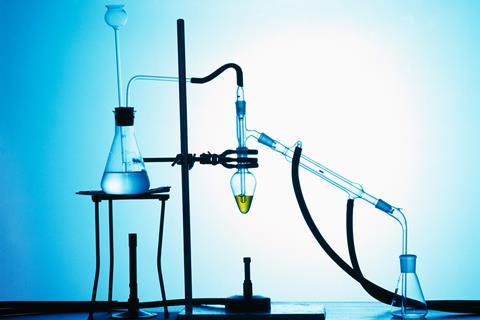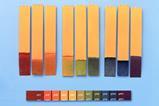Help your students master organic synthesis with these ideas and resources

We use many different synthetic molecules in our everyday lives. These are found in obvious products like medicines, but also in our food, detergents and clothing. A glance at the ingredients list of any of these products reveals a huge variety of compounds. All these molecules are made in chemical plants and their synthesis generally requires more than one step. Chemists carefully design their synthetic routes to balance the yield and purity of product with other factors like the rate of reaction, hazards and waste implications.
Organic synthesis is based on the versatility of carbon atoms. Carbon can form four bonds per atom; it can form single, double or triple bonds, and can bond with many elements – and with itself. The synthetic pathways that can be drawn for organic molecules are infinite, although thankfully not within the confines set by most advanced chemistry specifications.
What students need to know
The exact range of synthetic routes covered differs by exam board, so check exactly which ones are required for your class. This topic is the very last part of organic chemistry for most courses, where all the individual parts form a bigger picture. This means that students need a lot of varied knowledge to access questions and successfully answer them.
-

Download this
Quiz, for age range 16–18
Use this multiple choice quiz to engage post-16 classes and revise key organic chemistry topics.
Download the quiz as MS PowerPoint or pdf and the teacher notes and answers as MS Word or pdf.
Typically, students need to able to:
- state reagents and conditions for the interconversion of functional groups in individual or multiple steps in a synthesis.
- confidently switch between the multiple representations of compounds, such as empirical, molecular, displayed and skeletal formula, as well as be able to apply meaning to those structures.
- name and outline the mechanism for particular transformations.
- identify the structure of missing reactants, products and by-products in reaction schemes.
- give reasons for the structural or stereoisomerism observed in schemes.
If you are new to teaching this topic for 16–18 year olds, or need a refresher, the RSC on-demand CPD course on carbon chemistry has a section devoted to synthesis. You can take these courses whenever you need them and you only need a free RSC login to gain access.
If you are new to teaching this topic for 16–18 year olds, or need a refresher, the RSC on-demand CPD course on carbon chemistry (rsc.li/3qVHQlN) has a section devoted to synthesis. You can take these courses whenever you need them and you only need a free RSC login to gain access.
Common misconceptions

It’s common for students (and teachers) to think of synthesis as a vast body of facts that needs to be learned. Although this is the case for some aspects, like reagents and conditions, these simple recall items don’t tend to make up many of the marks for the topic in exams. Students will meet with relatively limited success if they just try to learn facts, no matter how much retrieval practice they do.
Students may also struggle to consider alternative reactants or ways to solve problems if they have just learned each reaction as an isolated fact. For example, if a student learns that a particular reaction uses sodium hydroxide, they may not recognise that the reaction with potassium hydroxide is likely to proceed in a similar fashion.
Ideas for your classroom
Use the RSC Synthesis explorer resource to help students tie ideas together. They can plan their own synthetic routes and see how the physical properties and spectra change as each functional group is switched. You can use this resource to introduce, explore or revise organic synthesis.
Start lessons with short exercises, such as the RSC’s Starters for ten resource on organic synthesis.
Give students practical experience of a two-step synthesis. Having more than one step is a little unusual for students and risks can be managed by using microscale techniques. For example, students can perform the synthesis of an orange-red azo dye using two steps; diazotisation and coupling. Unusually, the synthesis is done in an ice bath – most of the experiments at this level are done at room or elevated temperature.
If laboratory time is limited, then you can use the aspirin screen experiment. This resource is a flexible tool for teachers and students, which allows students to run their own reactions online before doing the real thing. The resource is supported by teacher notes. If you make sure students are familiar with the different steps before lab work begins, practical work will be more productive.
You can support understanding of the practical techniques used in organic synthesis by using videos such as this one showing the synthesis of an organic liquid. You could use this video as a pre-lab exercise to familiarise students with the correct techniques before they attempt the practical themselves. This adds value to the practical experience and should ensure the lesson runs smoothly.
Incorporate and explore careers linked to organic synthesis with the RSC’s Making the difference series of job profiles. Relevant case studies include a medicinal chemist in a university lab, director of medicinal chemistry for a large pharmaceutical company and a process chemistry apprentice.
Use the RSC Synthesis explorer (rsc.li/3S1PtmP) resource to help students tie ideas together. They can plan their own synthetic routes and see how the physical properties and spectra change as each functional group is switched. You can use this resource to introduce, explore or revise organic synthesis.
Start lessons with short exercises, such as the RSC’s Starters for ten resource on organic synthesis (rsc.li/3Uv4qzc).
Give students practical experience of a two-step synthesis. Having more than one step is a little unusual for students and risks can be managed by using microscale techniques. For example, students can perform the synthesis of an orange-red azo dye using two steps; diazotisation and coupling. Unusually, the synthesis is done in an ice bath – most of the experiments at this level are done at room or elevated temperature.
If laboratory time is limited, then you can use the aspirin screen experiment (rsc.li/3BC8fdk). This resource is a flexible tool for teachers and students, which allows students to run their own reactions online before doing the real thing. The resource is supported by teacher notes. If you make sure students are familiar with the different steps before lab work begins, practical work will be more productive.
You can support understanding of the practical techniques used in organic synthesis by using videos such as this one (rsc.li/3UtA2W7) showing the synthesis of an organic liquid. You could use this video as a pre-lab exercise to familiarise students with the correct techniques before they attempt the practical themselves. This adds value to the practical experience and should ensure the lesson runs smoothly.
Incorporate and explore careers linked to organic synthesis with the RSC’s Making the difference series of job profiles (rsc.li/3SgI9DK). Relevant case studies include a medicinal chemist in a university lab, director of medicinal chemistry for a large pharmaceutical company and a process chemistry apprentice.
Checking students’ understanding
Individual strands within organic synthesis lend themselves to quick retrieval of some aspects and, because students often leave practice to the last minute, regular quick formative quizzes are helpful to build knowledge over time. You can use a number of different quiz techniques to add variety; quiz apps can be motivating for students.
Gap filling exercises, where students are given partial schemes and asked to add structures, are an effective way to practise problem solving. Make sure you include different representations of molecules in any questions so students can gain confidence with multiple representations.
Take home point
Organic synthesis is not really a topic on its own. It is better to consider it as a tying together of all the aspects of organic chemistry taught in a course. It can seem like a vast body of facts, but students should be encouraged to think more deeply by using a mixture of retrieval practice and problem-solving exercises.
Kristy Turner is a school teacher fellow at University of Manchester/Bolton School














1 Reader's comment